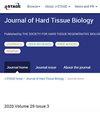Morphological Analysis of Angiotensin-Converting Enzyme 2 Expression in the Salivary Glands and Associated Tissues
IF 0.4
4区 医学
Q4 ENGINEERING, BIOMEDICAL
引用次数: 4
Abstract
We evaluated localization of angiotensin-converting enzyme 2 (ACE2), the receptor for severe acute respiratory syndrome coronavirus 2 (SARS-CoV-2), in the salivary and associated tissues using immunohistochemistry. Fifty paraffin-embedded blocks from 48 anonymized patients, biopsied or operated on for diseases of the oral and maxillofacial region before 2010, were analyzed. ACE2-expressing cells were observed in the parotid, sublingual and the buccal glands, the conduits, the acinar regions of the serous glands, and sparsely in the mucous glands. Scattered ACE2-positive endothelial cells were also observed in nearby capillaries nourishing the salivary glands, as well as in the juxta-epithelial capillaries of the oral mucosa. ACE-2-positive adipocytes were scattered within the stroma of the parotid gland. These observations suggest the possibility that SARS-CoV-2 may travel through the bloodstream to the capillaries that nourish the salivary glands and oral mucosa, and inducing vasculitis and damage of oral tissues. SARS-CoV-2 infection of salivary glands through the bloodstream implies the main cause of salivary contamination. Similarly, ascending infection from oral fluid to the salivary gland conduit has been shown to be another possible mute. Moreover, infection of ACE2-positive parotid adipocytes may lead to parotid glands inflammation and contribute to systemic progression of coronavirus disease 2019.唾液腺及相关组织中血管紧张素转换酶2表达的形态学分析
我们利用免疫组织化学方法评估了严重急性呼吸综合征冠状病毒2 (SARS-CoV-2)受体血管紧张素转换酶2 (ACE2)在唾液和相关组织中的定位。本文分析了2010年以前48例匿名口腔颌面部病变活检或手术患者的50块石蜡包埋块。腮腺、舌下腺、颊腺、导管、浆液腺腺泡区均可见表达ace2的细胞,粘液腺中表达ace2的细胞较少。在唾液腺附近的毛细血管以及口腔黏膜上皮旁毛细血管中也可见分散的ace2阳性内皮细胞。ace -2阳性脂肪细胞散在腮腺间质内。这些观察结果表明,SARS-CoV-2可能会通过血液进入滋养唾液腺和口腔粘膜的毛细血管,并诱发血管炎和口腔组织损伤。SARS-CoV-2通过血液感染唾液腺意味着唾液腺污染的主要原因。同样,从口腔液体到唾液腺导管的上行感染已被证明是另一种可能的沉默。此外,ace2阳性腮腺脂肪细胞感染可能导致腮腺炎症,并促进2019冠状病毒病的全身进展。
本文章由计算机程序翻译,如有差异,请以英文原文为准。
求助全文
约1分钟内获得全文
求助全文
来源期刊

Journal of Hard Tissue Biology
ENGINEERING, BIOMEDICAL-
CiteScore
0.90
自引率
0.00%
发文量
28
审稿时长
6-12 weeks
期刊介绍:
Information not localized
 求助内容:
求助内容: 应助结果提醒方式:
应助结果提醒方式:


